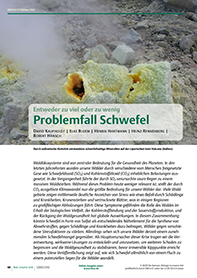The problematic case sulphur – either toomuch or too little
DOI:
https://doi.org/10.11576/biuz-7823Keywords:
Pflanzlicher Schwefelmetabolismus, Waldsterben, Schwefeldioxid, Sulfat, Stress, Schwefel-induzierte ResistenzAbstract
Sulphur is an essential macro-element that plays an important role in numerous biological processes. It is present as bioavailable sulfate in minerals such as gypsum, but is also released in gaseous form by human activities, marine organisms, volcanic eruptions or forest fires in the form of sulphur dioxide (SO2). For many years, the use of fossil fuels caused SO2 concentrations that were even toxic to plants and led to a widespread forest dieback, while today’s SO2 concentrations in the atmosphere are almost zero, at least in Europe. Therefore, this reduced supply of sulphur and at the same time the export of sulphur because of timber harvesting in managed forests has led to a shortage situation and a reduced resilience of trees, as sulphur is essential for a variety of defence reactions against biotic stressors. In agriculture, the lack of sulphur and its impact on plant health is known and today sulphur fertilization is common practice. Apparently, this phenomenon has arrived in our forests as well and many damage symptoms of trees can possibly be traced back to an insufficient uptake of sulphur. That is why ideas are being discussed as to the use of systematic sulphur applications for the regeneration of the natural supply of sulphur. Therefore, in analogy to agriculture, the natural resilience of our native trees could be restored in the future – at least partly. As a consequence, sulphur in the forest has turned from a curse to a blessing during the last decades.


